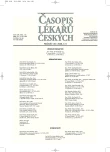Evaluation of DHPLC Analysis for Mutation Detection in Haemophilia A
Testování DHPLC analýzy pro detekci mutací u hemofilie A
Východisko.
Hemofilie A je jednou z nejčastějších vrozených krvácivých poruch. Znalost molekulární příčiny onemocnění je využívána při genetickém poradenství a pomáhá odhadnout riziko závažné komplikace standardní léčby (inhibitor faktoru VIII). Deficit faktoru VIII je způsoben širokým spektrem mutací. Pouze inverze s místy zlomu v intronech 22, respektive 1 se vyskytují častěji. Ostatní mutace je nutno hledat v celém rozsahu 26 exonů kódujících 9 kb mRNA a v přilehlých nekódujících sekvencích. Cílem práce bylo metodicky zajistit urychlení genotypizace hemofilických rodin v České republice využitím analýzy amplikonů jednotlivých exonů genu faktoru VIII pomocí denaturační vysokotlaké kapalinové chromatografie.
Metody a výsledky.
Citlivost metody jsme ověřovali na panelu vzorků DNA se 49 dříve charakterizovanými různými sekvenčními variantami genu faktoru VIII, celkem ve 21 exonech. Všechny testované sekvenční změny byly snadno detekovány. Testování příbuzných ukázalo velmi dobrou reprodukovatelnost jednotlivých elučních profilů. Navíc se podařilo detekovat kauzální mutace u 4 z 5 zjevně nepříbuzných hemofilických rodin, u kterých nebyla předchozí analýza metodou multiplexní CSGE úspěšná.
Závěry.
Zavedená metoda významně urychlí genotypizaci rodin s hemofilií A v České republice.
Klíčová slova:
hemofilie A, gen faktoru VIII, detekce mutací, denaturační vysokotlaké kapalinové chromatografie.
Authors:
D. Habart; Z. Kleibl 1; I. Hrachovinová
Authors‘ workplace:
Ústav hematologie a krevní transfuze, Praha
; Ústav biochemie a experimentální onkologie 1. LF UK, Praha
2
Published in:
Čas. Lék. čes. 2006; 145: 484-487
Category:
Original Article
Overview
Background.
Haemophilia A is one of the most prevalent inherited bleeding disorders. Causal mutations in the factor VIII gene are detected to facilitate the genetic counselling and to estimate the risk of serious complication associated with standard treatment (factor VIII inhibitor). Wide range of mutations located across the entire length of the factor VIII gene underlies the factor VIII deficiency of variable severity. The only two common recurrent mutations in the factor VIII gene are intron 22 and intron 1 inversions. In the remaining cases it is necessary to screen all 26 exons encoding 9kb mRNA together with adjacent nonncoding sequences. In order to speed up genotyping in haemophilia A families in the Czech Republic we evaluated DHPLC-based screening technique.
Methods and Results.
We tested sensitivity of the analysis on a panel of DNA samples containing 49 different sequence variations distributed over 21 exons. All the genetic alterations were readily detected. Analysis of family members has shown good reproducibility of the respective elution patterns. DHPLC analysis detected mutations in 4 out of 5 samples from apparently unrelated haemophilia patients, where previously applied multiplex CSGE was not successful.
Conclusions.
Establishing of DHPLC analysis will substantially speed up the genotyping of haemophilia A families in the Czech Republic.
Key words:
haemophilia A, factor VIII gene, mutation detection, DHPLC.
Labels
Addictology Allergology and clinical immunology Angiology Audiology Clinical biochemistry Dermatology & STDs Paediatric gastroenterology Paediatric surgery Paediatric cardiology Paediatric neurology Paediatric ENT Paediatric psychiatry Paediatric rheumatology Diabetology Pharmacy Vascular surgery Pain management Dental HygienistArticle was published in
Journal of Czech Physicians

- Metamizole vs. Tramadol in Postoperative Analgesia
- Metamizole at a Glance and in Practice – Effective Non-Opioid Analgesic for All Ages
- Advances in the Treatment of Myasthenia Gravis on the Horizon
- Metamizole in perioperative treatment in children under 14 years – results of a questionnaire survey from practice
- Possibilities of Using Metamizole in the Treatment of Acute Primary Headaches
Most read in this issue
- Faecal Elastase I. Assessment – Its Use in Diagnosis of Chronic Pancreatitis
- Injury of the Scapholunate Interosseal Ligament – Scapholunate Dissociation
- Hyperamylasemia, Laboratory and Clinical Aspects
- Capsule Endoscopy – The Past, Presence, and Future
